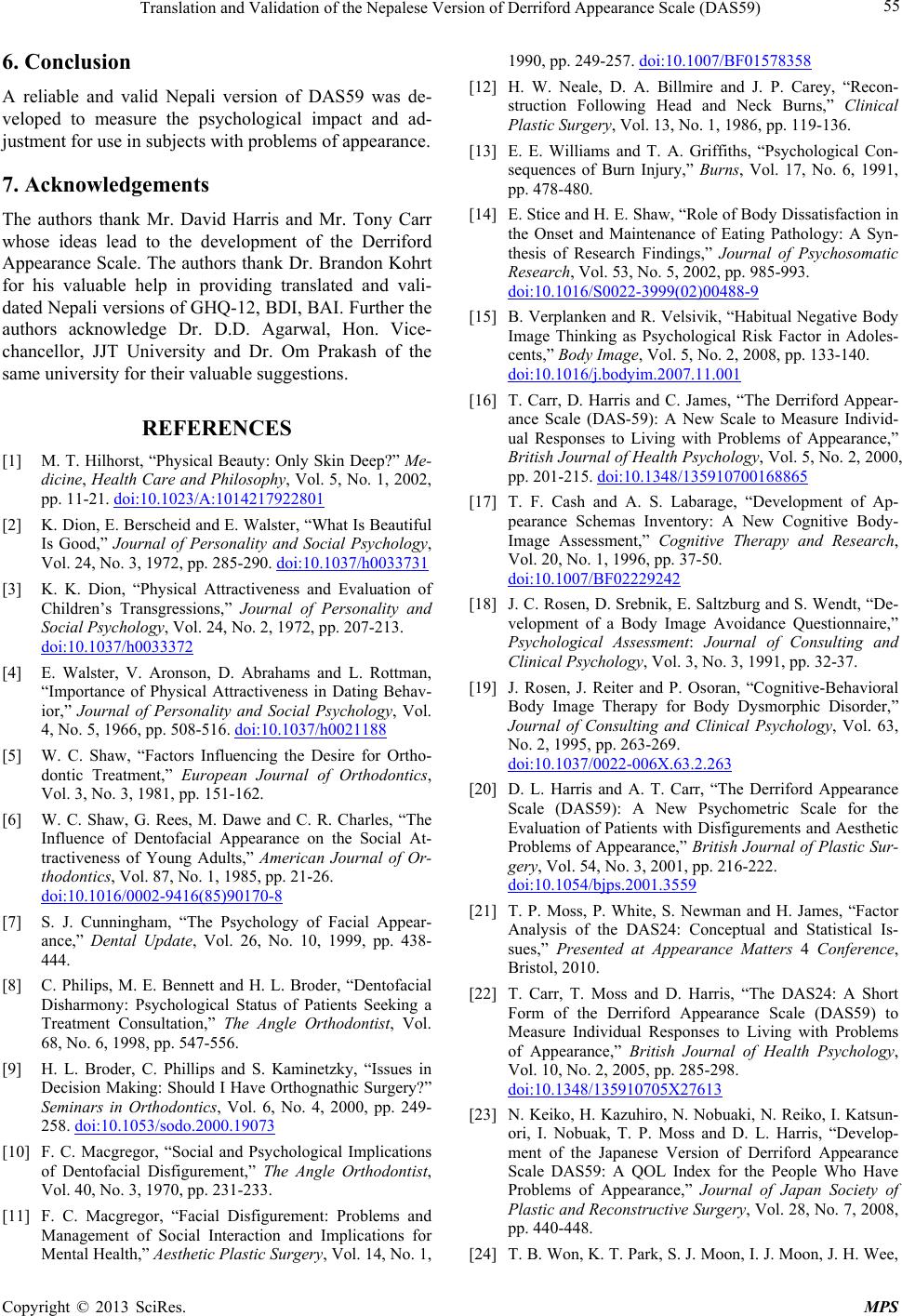
Translation and Validation of the Nepalese Version of Derriford Appearance Scale (DAS59) 55
6. Conclusion
A reliable and valid Nepali version of DAS59 was de-
veloped to measure the psychological impact and ad-
justment for use in subjects with problems of appearance.
7. Acknowledgements
The authors thank Mr. David Harris and Mr. Tony Carr
whose ideas lead to the development of the Derriford
Appearance Scale. The authors thank Dr. Brandon Kohrt
for his valuable help in providing translated and vali-
dated Nepali versions of GHQ-12, BDI, BAI. Further the
authors acknowledge Dr. D.D. Agarwal, Hon. Vice-
chancellor, JJT University and Dr. Om Prakash of the
same university for their valuable suggestions.
REFERENCES
[1] M. T. Hilhorst, “Phy sical Beauty: Only Skin Deep?” Me-
dicine, Health Care and Philosophy, Vol. 5, No. 1, 2002,
pp. 11-21. doi:10.1023/A:1014217922801
[2] K. Dion, E. Berscheid and E. Walster, “What Is Beautiful
Is Good,” Journal of Personality and Social Psychology,
Vol. 24, No. 3, 1972, pp. 285-290. doi:10.1037/h0033731
[3] K. K. Dion, “Physical Attractiveness and Evaluation of
Children’s Transgressions,” Journal of Personality and
Social Psychology, Vol. 24, No. 2, 1972, pp. 207-213.
doi:10.1037/h0033372
[4] E. Walster, V. Aronson, D. Abrahams and L. Rottman,
“Importance of Physical Attractiveness in Dating Behav-
ior,” Journal of Personality and Social Psychology, Vol.
4, No. 5, 1966, pp. 508-516. doi:10.1037/h0021188
[5] W. C. Shaw, “Factors Influencing the Desire for Ortho-
dontic Treatment,” European Journal of Orthodontics,
Vol. 3, No. 3, 1981, pp. 151-162.
[6] W. C. Shaw, G. Rees, M. Dawe and C. R. Charles, “The
Influence of Dentofacial Appearance on the Social At-
tractiveness of Young Adults,” American Journal of Or-
thodontics, Vol. 87, No. 1, 1985, pp. 21-26.
doi:10.1016/0002-9416(85)90170-8
[7] S. J. Cunningham, “The Psychology of Facial Appear-
ance,” Dental Update, Vol. 26, No. 10, 1999, pp. 438-
444.
[8] C. Philips, M. E. Bennett and H. L. Broder, “Dentofacial
Disharmony: Psychological Status of Patients Seeking a
Treatment Consultation,” The Angle Orthodontist, Vol.
68, No. 6, 1998, pp. 547-556.
[9] H. L. Broder, C. Phillips and S. Kaminetzky, “Issues in
Decision Making: Should I Have Orthognathic Surgery?”
Seminars in Orthodontics, Vol. 6, No. 4, 2000, pp. 249-
258. doi:10.1053/sodo.2000.19073
[10] F. C. Macgregor, “Social and Psychological Implications
of Dentofacial Disfigurement,” The Angle Orthodontist,
Vol. 40, No. 3, 1970, pp. 231-233.
[11] F. C. Macgregor, “Facial Disfigurement: Problems and
Management of Social Interaction and Implications for
Mental Health,” Aesthetic Plastic Surgery, Vol. 14, No. 1,
1990, pp. 249-257. doi:10.1007/BF01578358
[12] H. W. Neale, D. A. Billmire and J. P. Carey, “Recon-
struction Following Head and Neck Burns,” Clinical
Plastic Surgery, Vol. 13, No. 1, 1986, pp. 119-136.
[13] E. E. Williams and T. A. Griffiths, “Psychological Con-
sequences of Burn Injury,” Burns, Vol. 17, No. 6, 1991,
pp. 478-480.
[14] E. Stice and H. E. Shaw, “Role of Body Dissatisfaction in
the Onset and Maintenance of Eating Pathology: A Syn-
thesis of Research Findings,” Journal of Psychosomatic
Research, Vol. 53, No. 5, 2002, pp. 985-993.
doi:10.1016/S0022-3999(02)00488-9
[15] B. Verplanken and R. Velsivik, “Habitual Negative Body
Image Thinking as Psychological Risk Factor in Adoles-
cents,” Body Image, Vol. 5, No. 2, 2008, pp. 133-140.
doi:10.1016/j.bodyim.2007.11.001
[16] T. Carr, D. Harris and C. James, “The Derriford Appear-
ance Scale (DAS-59): A New Scale to Measure Individ-
ual Responses to Living with Problems of Appearance,”
British Journal of Health Psychology, Vol. 5, No. 2, 2000,
pp. 201-215. doi:10.1348/135910700168865
[17] T. F. Cash and A. S. Labarage, “Development of Ap-
pearance Schemas Inventory: A New Cognitive Body-
Image Assessment,” Cognitive Therapy and Research,
Vol. 20, No. 1, 1996, pp. 37-50.
doi:10.1007/BF02229242
[18] J. C. Rosen, D. Srebnik, E. Saltzburg and S. Wendt, “De-
velopment of a Body Image Avoidance Questionnaire,”
Psychological Assessment: Journal of Consulting and
Clinical Psychology, Vol. 3, No. 3, 1991, pp. 32-37.
[19] J. Rosen, J. Reiter and P. Osoran, “Cognitive-Behavioral
Body Image Therapy for Body Dysmorphic Disorder,”
Journal of Consulting and Clinical Psychology, Vol. 63,
No. 2, 1995, pp. 263-269.
doi:10.1037/0022-006X.63.2.263
[20] D. L. Harris and A. T. Carr, “The Derriford Appearance
Scale (DAS59): A New Psychometric Scale for the
Evaluation of Patients with Disfigurements and Aesthetic
Problems of Appearance,” British Journal of Plastic Sur-
gery, Vol. 54, No. 3, 2001, pp. 216-222.
doi:10.1054/bjps.2001.3559
[21] T. P. Moss, P. White, S. Newman and H. James, “Factor
Analysis of the DAS24: Conceptual and Statistical Is-
sues,” Presented at Appearance Matters 4 Conference,
Bristol, 2010.
[22] T. Carr, T. Moss and D. Harris, “The DAS24: A Short
Form of the Derriford Appearance Scale (DAS59) to
Measure Individual Responses to Living with Problems
of Appearance,” British Journal of Health Psychology,
Vol. 10, No. 2, 2005, pp. 285-298.
doi:10.1348/135910705X27613
[23] N. Keiko, H. Kazuhiro, N. Nobuaki, N. Reiko, I. Katsun-
ori, I. Nobuak, T. P. Moss and D. L. Harris, “Develop-
ment of the Japanese Version of Derriford Appearance
Scale DAS59: A QOL Index for the People Who Have
Problems of Appearance,” Journal of Japan Society of
Plastic and Reconstructive Surgery, Vol. 28, No. 7, 2008,
pp. 440-448.
[24] T. B. Won, K. T. Park, S. J. Moon, I. J. Moon, J. H. Wee,
Copyright © 2013 SciRes. MPS